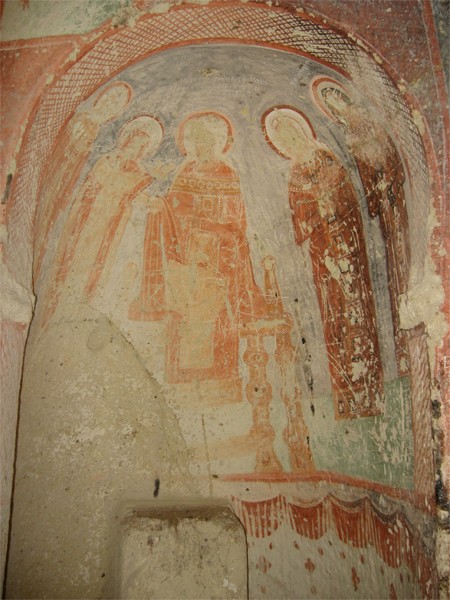My time as a visiting senior fellow at CASVA allowed me to complete one chapter of my book, “Visions of Death and Resurrection in the Rock-Cut Churches of Cappadocia.” This chapter focuses on the documentation of a cult dedicated to Emperor Nikephoros II Phokas (r. 963–969). Ruler cults were a standard component of the Roman Empire, but little scholarship has focused on the continuation of this practice in Byzantium.
Although only one emperor, Constantine I, is recognized as a saint by the Orthodox Church, during the Middle Byzantine period (843–1204) many if not most emperors and empresses were informally granted sacred status upon death by the church and, often, by the succeeding ruler. There was a conventional process for conferring saintly status on the nonimperial dead, and I argue that it was the same process used for murdered emperors such as Nikephoros II: local ecclesiastical authorities approved popular cults and introduced them into the liturgy. In most cases, imperial and otherwise, noncanonical status quickly fell away. In the case of Nikephoros II Phokas, textual evidence suggests that his cult, established immediately upon death, subsided during the late tenth century, only to reappear, strengthened, in the eleventh and twelfth centuries.
In the northeast apse of the rock-cut church of Cavusin in Cappadocia is an image that dates to 963–969, identified by an inscription as Nikephoros II. Painted on the north wall, as if processing toward the emperor, are his most notable generals, leading a heavenly army of military saints. This decorative scheme raises many questions. One of the generals, John Tzimiskes, colluded with Nikephoros’s wife, Theophano, in his murder, assuming the imperial throne in 969. The preservation of both Tzimiskes’s and Theophano’s images provides evidence, I suggest, of the efficiency of Emperor Basil II’s policy against the great landed military families of Cappadocia, including the Phokaides. They were stripped of their lands and relocated in the eastern border territories.
Evidence of the Phokaides’ recovery is found in late tenth- and
eleventh-century texts and works of art featuring Nikephoros II. Their return to prominence was certainly well established by 1022, when Nikephoros “the wry-necked” Phokas, great-nephew of Nikephoros II, led a revolt against Basil II (r. 976–1025). Nikephoros “the wry-necked” was proclaimed emperor in Cappadocia by an army composed of military aristocracy whose power had been weakened by Basil II. The event was significant enough to be recorded in Byzantine, Armenian, Georgian, and Arabic contemporary histories. The revolt ended with the death of Nikephoros.
This resurgence of the Phokas family in Cappadocia provides context for a revived interest in Nikephoros II as well as for his renewed sainthood. Textual accounts of the late tenth and early eleventh centuries rewrite Nikephoros’s pious life. He is consistently paired with the Israelite leader Joshua in visions he is said to have received before successful battles against the Arabs, in
Nikephoros II, I argue, was (re)granted sanctity in the early eleventh century in order to assert his descendants’ right to claim imperial status. The emphasis on his piety was calculated to stoke the fires of discontent among the great military families of Cappadocia, whose status and wealth had been decimated by Basil II. Although this sociopolitical agenda was, of course, intended to serve a very specific, short-term goal, I argue that the pious renovation of Nikephoros II continued after the revolt of 1022 was suppressed. The symbolic relationship with Joshua established during and immediately after Nikephoros’s lifetime, in art and text, again acquired popular currency in Cappadocia. In each
This study furthers our knowledge of the many ways in which imperial sanctity was established in the Middle Byzantine period. Monastic authority was region-specific and limited in its ability to declare and maintain sainthood. Regional popular devotion is thought to have had more impact in establishing and maintaining cults of “unrecognized” saints—but such popular cults have left little evidence, and unrecognized saints tend to remain so. In the case of Nikephoros II we have, I suggest, evidence of the ways in which an imperial cult was invented, disavowed, resurrected, and continued over a period of 120 years.
